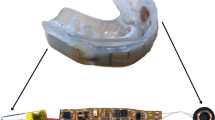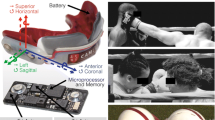Abstract
Because of the rigid coupling between the upper dentition and the skull, instrumented mouthguards have been shown to be a viable way of measuring head impact kinematics for assisting in understanding the underlying biomechanics of concussions. This has led various companies and institutions to further develop instrumented mouthguards. However, their use as a research tool for understanding concussive impacts makes quantification of their accuracy critical, especially given the conflicting results from various recent studies. Here we present a study that uses a pneumatic impactor to deliver impacts characteristic to football to a Hybrid III headform, in order to validate and compare five of the most commonly used instrumented mouthguards. We found that all tested mouthguards gave accurate measurements for the peak angular acceleration, the peak angular velocity, brain injury criteria values (mean average errors < 13, 8, 13%, respectively), and the mouthguards with long enough sampling time windows are suitable for a convolutional neural network-based brain model to calculate the brain strain (mean average errors < 9%). Finally, we found that the accuracy of the measurement varies with the impact locations yet is not sensitive to the impact velocity for the most part.








Similar content being viewed by others
Change history
02 February 2021
A Correction to this paper has been published: https://doi.org/10.1007/s10439-020-02701-y
References
Bartsch A., S. Samorezov, E. Benzel, V. Miele, and D. Brett. Validation of an “Intelligent Mouthguard” Single Event Head Impact Dosimeter. SAE Technical Paper, 2014.
Bridgman, H., M. T. Kwong, and J. H. Bergmann. Mechanical safety of embedded electronics for in-body wearables: a smart mouthguard study. Ann. Biomed. Eng. 47:1725–1737, 2019.
Camarillo, D. B., P. B. Shull, J. Mattson, R. Shultz, and D. Garza. An instrumented mouthguard for measuring linear and angular head impact kinematics in American football. Ann. Biomed. Eng. 41:1939–1949, 2013.
Coats, B., S. A. Eucker, S. Sullivan, and S. S. Margulies. Finite element model predictions of intracranial hemorrhage from non-impact, rapid head rotations in the piglet. Int. J. Dev. Neurosci. 30:191–200, 2012.
Fanton, M., C. Kuo, J. Sganga, F. Hernandez, and D. B. Camarillo. Dependency of head impact rotation on head-neck positioning and soft tissue forces. IEEE Trans. Biomed. Eng. 66:988–999, 2018.
Fanton, M., J. Sganga, and D. B. Camarillo. Vulnerable locations on the head to brain injury and implications for helmet design. J. Biomech. Eng. 141:121002, 2019.
Force Impact Technologies. FITGuard. https://fitguard.me/.
Funk J., J. Crandall, M. Wonnacott, C. Withnall, and D. Drive. NFL Linear Impactor Helmet Test Protocol. Biocore, Charlottesville, VA. Accessed 1 Feb 2019, 2017.
Gabler, L. F., H. Joodaki, J. R. Crandall, and M. B. Panzer. Development of a single-degree-of-freedom mechanical model for predicting strain-based brain injury responses. J. Biomech. Eng. 140:031002, 2018.
Giordano, C., S. Zappalà, and S. Kleiven. Anisotropic finite element models for brain injury prediction: the sensitivity of axonal strain to white matter tract inter-subject variability. Biomech. Model. Mechanobiol. 16:1269–1293, 2017.
Greenwald, R. M., J. T. Gwin, J. J. Chu, and J. J. Crisco. Head impact severity measures for evaluating mild traumatic brain injury risk exposure. Neurosurgery 62:789–798, 2008.
Hajiaghamemar, M., M. Seidi, and S. Margulies. Head rotational kinematics, tissue deformations, and their relationships to the acute traumatic axonal injury. J. Biomech. Eng. 142:031006, 2020.
Hernandez, F., L. C. Wu, M. C. Yip, K. Laksari, A. R. Hoffman, J. R. Lopez, G. A. Grant, S. Kleiven, and D. B. Camarillo. Six degree-of-freedom measurements of human mild traumatic brain injury. Ann. Biomed. Eng. 43:1918–1934, 2015.
hitIQ. Nexus A9. https://hitiq.com/.
Kuo, C., M. Fanton, L. Wu, and D. Camarillo. Spinal constraint modulates head instantaneous center of rotation and dictates head angular motion. J. Biomech. 76:220–228, 2018.
Kuo, C., L. C. Wu, B. T. Hammoor, J. F. Luck, H. C. Cutcliffe, R. C. Lynall, J. R. Kait, K. R. Campbell, J. P. Mihalik, C. R. Bass, and D. B. Camarillo. Effect of the mandible on mouthguard measurements of head kinematics. J. Biomech. 49:1845–1853, 2016.
Kuo, C., L. Wu, W. Zhao, M. Fanton, S. Ji, and D. B. Camarillo. Propagation of errors from skull kinematic measurements to finite element tissue responses. Biomech. Model. Mechanobiol. 17:235–247, 2018.
Laksari, K., M. Fanton, L. C. Wu, T. H. Nguyen, M. Kurt, C. Giordano, E. Kelly, E. O’Keeffe, E. Wallace, and C. Doherty. Multi-directional dynamic model for traumatic brain injury detection. J. Neurotrauma 37:982–993, 2020.
Laksari, K., M. Kurt, H. Babaee, S. Kleiven, and D. Camarillo. Mechanistic insights into human brain impact dynamics through modal analysis. Phys. Rev. Lett. 120:138101, 2018.
Laksari, K., L. C. Wu, M. Kurt, C. Kuo, and D. C. Camarillo. Resonance of human brain under head acceleration. J. R. Soc. Interface 12:20150331, 2015.
Langlois, J. A., W. Rutland-Brown, and M. M. Wald. The epidemiology and impact of traumatic brain injury: a brief overview. J. Head Trauma Rehabil. 21:375–378, 2006.
Li X., Z. Zhou, and S. Kleiven. An anatomically accurate and personalizable head injury model: significance of brain and white matter tract morphological variability on strain. bioRxiv, 2020.
Lu, Y.-C., N. P. Daphalapurkar, A. Knutsen, J. Glaister, D. Pham, J. Butman, J. L. Prince, P. Bayly, and K. Ramesh. A 3D computational head model under dynamic head rotation and head extension validated using live human brain data, including the falx and the tentorium. Ann. Biomed. Eng. 47:1923–1940, 2019.
Margulies, S. S., and L. E. Thibault. A proposed tolerance criterion for diffuse axonal injury in man. J. Biomech. 25:917–923, 1992.
Miller, L. E., E. K. Pinkerton, K. C. Fabian, L. C. Wu, M. A. Espeland, L. C. Lamond, C. M. Miles, D. B. Camarillo, J. D. Stitzel, and J. E. Urban. Characterizing head impact exposure in youth female soccer with a custom-instrumented mouthpiece. Res. Sports Med. 28:55–71, 2020.
O’Keeffe, E., E. Kelly, Y. Liu, C. Giordano, E. Wallace, M. Hynes, S. Tiernan, A. Meagher, C. Greene, and S. Hughes. Dynamic blood-brain barrier regulation in mild traumatic brain injury. J. Neurotrauma 37:347–356, 2020.
Parivash, S. N., M. Goubran, B. D. Mills, P. Rezaii, C. Thaler, D. Wolman, W. Bian, L. A. Mitchell, B. Boldt, and D. Douglas. Longitudinal changes in hippocampal subfield volume associated with collegiate football. J. Neurotrauma 36:2762–2773, 2019.
Rich, A. M., T. M. Filben, L. E. Miller, B. T. Tomblin, A. R. Van Gorkom, M. A. Hurst, R. T. Barnard, D. S. Kohn, J. E. Urban, and J. D. Stitzel. Development, validation and pilot field deployment of a custom mouthpiece for head impact measurement. Ann. Biomed. Eng. 47:2109–2121, 2019.
Seifert, T. D. Sports concussion and associated post-traumatic headache. Headache: J. Head Face Pain 53:726–736, 2013.
Siegmund, G. P., K. M. Guskiewicz, S. W. Marshall, A. L. DeMarco, and S. J. Bonin. A headform for testing helmet and mouthguard sensors that measure head impact severity in football players. Ann. Biomed. Eng. 42:1834–1845, 2014.
Siegmund, G. P., K. M. Guskiewicz, S. W. Marshall, A. L. DeMarco, and S. J. Bonin. Laboratory validation of two wearable sensor systems for measuring head impact severity in football players. Ann. Biomed. Eng. 44:1257–1274, 2016.
SISU. SISU Sense. https://www.sisuguard.com/sisu-sense-electronic-mouth-guard/.
Takhounts E. G., M. J. Craig, K. Moorhouse, J. McFadden, and V. Hasija. Development of Brain Injury Criteria (BrIC). SAE Technical Paper, 2013.
Tiernan, S., A. Meagher, D. O’Sullivan, E. O’Keeffe, E. Kelly, E. Wallace, C. P. Doherty, M. Campbell, Y. Liu, and A. G. Domel. Concussion and the severity of head impacts in mixed martial arts. Proc. Inst. Mech. Eng. Part H J. Eng. Med. 2020. https://doi.org/10.1177/0954411920947850.
Wu, L. C., C. Kuo, J. Loza, M. Kurt, K. Laksari, L. Z. Yanez, D. Senif, S. C. Anderson, L. E. Miller, and J. E. Urban. Detection of American football head impacts using biomechanical features and support vector machine classification. Sci. Rep. 8:1–14, 2017.
Wu, L. C., V. Nangia, K. Bui, B. Hammoor, M. Kurt, F. Hernandez, C. Kuo, and D. B. Camarillo. In vivo evaluation of wearable head impact sensors. Ann. Biomed. Eng. 44:1234–1245, 2016.
Wu, S., W. Zhao, K. Ghazi, and S. Ji. Convolutional neural network for efficient estimation of regional brain strains. Sci. Rep. 9:1–11, 2019.
Yoganandan, N., J. Li, J. Zhang, F. A. Pintar, and T. A. Gennarelli. Influence of angular acceleration–deceleration pulse shapes on regional brain strains. J. Biomech. 41:2253–2262, 2008.
Zhao, W., and S. Ji. White matter anisotropy for impact simulation and response sampling in traumatic brain injury. J. Neurotrauma 36:250–263, 2019.
Zhao, W., and S. Ji. Incorporation of vasculature in a head injury model lowers local mechanical strains in dynamic impact. J. Biomech. 2020. https://doi.org/10.1016/j.jbiomech.2020.109732.
Acknowledgments
This research was supported by the Pac-12 Conference’s Student-Athlete Health and Well-Being Initiative, the National Institutes of Health (R24NS098518), Taube Stanford Children’s Concussion Initiative, and the Office of Naval Research Young Investigator Program (N00014-16-1-2949). The content of this article is solely the responsibility of the authors and does not necessarily represent the official views of funding agencies. It should be noted that the MiG mouthguard and intellectual property associated with it is owned by Stanford University. We would like to thank Dr. Michael Fanton, Dr. Hossein Vahid Alizadeh, and Dr. Sarah McGough for the insightful discussions on the development of the experimental protocol and data analysis. We also want to thank Prevent Biometrics and SWA companies for providing the mouthguards and answering any necessary questions.
Author information
Authors and Affiliations
Corresponding author
Additional information
Associate Editor Stefan M. Duma oversaw the review of this article.
Publisher's Note
Springer Nature remains neutral with regard to jurisdictional claims in published maps and institutional affiliations.
The original online version of this article was revised to correct the description about SWA mouthguard accuracy in the 6th sentence of the 11th paragraph (starting with “In summary, “) in the Discussion section. The original online version of this article was also revised to correct the corresponding author as Yuzhe Liu.
Electronic supplementary material
Below is the link to the electronic supplementary material.
Rights and permissions
About this article
Cite this article
Liu, Y., Domel, A.G., Yousefsani, S.A. et al. Validation and Comparison of Instrumented Mouthguards for Measuring Head Kinematics and Assessing Brain Deformation in Football Impacts. Ann Biomed Eng 48, 2580–2598 (2020). https://doi.org/10.1007/s10439-020-02629-3
Received:
Accepted:
Published:
Issue Date:
DOI: https://doi.org/10.1007/s10439-020-02629-3




